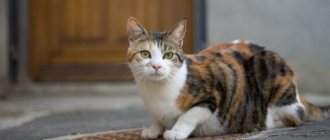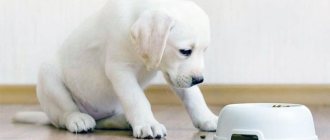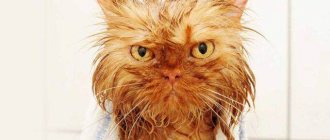What will you learn from the article?
- What can you do urgently before visiting a veterinarian?
- Urgent medical care
- Diseases that cause prolonged urinary retention
- The cat cannot go to the toilet - alarming symptoms
- Treatment options
- Special diet
- Prevention of diseases associated with difficulty urinating
A healthy adult cat's bladder should empty itself at least once a day. In some cases: moving, changing food, low activity of the animal, urination may be delayed for up to two days. If a cat cannot pee for more than two days or screams when trying to relieve itself, it must be urgently shown to a veterinarian.
What can you do urgently before visiting a veterinarian?
If it is not possible to quickly deliver the animal to a veterinarian, first aid should be provided by the cat's owners at home.
First aid is as follows: a warm compress or heating pad is placed on the stomach and perineal area. The heating pad and compress should be warm, but not hot! You can place the animal in a bath of warm water, making sure that the water does not reach the heart area.
It is forbidden to massage the cat's belly - this can cause serious complications.
Make sure that the cat drinks enough, and if he refuses to drink, force the animal to drink clean water from a pipette. Add some chicken broth to your regular food to increase your fluid intake. Play with your pet a little - this activates the work of all body systems. You need to play carefully so that the animal does not become overtired.
Urgent medical care
First aid in a veterinary clinic involves inserting a catheter. Only a professional should insert a catheter, after first flushing the bladder with antiseptics. This operation is painful, so it is performed under general anesthesia. After catheterization, the veterinarian performs a series of tests to find the cause of urinary retention.
Important: you should not insert a catheter often - after this procedure, swelling of the urinary tract occurs. If the doctor sewed in a catheter for several days, you need to keep the cat in a special collar during this time so that it does not injure itself and does not remove the catheter.
Diagnostics in a veterinary clinic
Urinary retention and its cause are determined on the basis of palpation, ultrasound and x-ray of a congested organ. In addition to bladder enlargement, these tests help diagnose kidney problems, tumors and stones.
Additionally, blood and urine tests are taken from the mustachioed patient. With their help, the causative agent of infection, the type of stones and the level of intoxication of the body are identified.
Diseases that cause prolonged urinary retention
If a cat cannot pee for more than two days, this may be symptoms of the following diseases:
- Cystitis is an inflammation of the mucous membrane of the bladder. The disease occurs due to infection entering the bladder or due to mechanical damage to the mucous membrane. Animals of all breeds and ages are prone to cystitis. Due to their anatomical features, cats get sick more often than cats. The presence of the disease is indicated by the fact that the cat does not go to the toilet very well - after the cat attempts to empty the bladder, small drops of urine are released. It hurts the cat to urinate, he screams heart-rendingly, rubbing against the walls of the tray. Over time, fear of pain makes the cat completely refuse to visit the litter box. In such cases, you should not postpone a visit to the veterinarian.
- Urethritis is an inflammation of the mucous membrane of the urethra. The disease usually develops against the background of cystitis. Neutered cats are most often susceptible to urethritis. If a castrated cat cannot pee, and after prolonged pushing, only droplets of urine appear in the tray, in which blood can be seen, then the animal urgently needs to be shown to a doctor.
- Urolithiasis (urolithiasis) is a pathology in which sand crystals and urinary stones form in the urinary tract and in the bladder itself. Sand and stones pass through the ureter, irritate and injure the mucous membrane, causing inflammation - the cat cannot go to the toilet without pain, and blood appears in the urine. In severe cases, the patency of the urinary tract is completely disrupted. Urolithiasis is a disease that requires urgent treatment. Only urgent surgery can solve the problem and save the pet’s life.
- Kidney diseases. The list of congenital and acquired diseases of this organ is long - cats are prone to kidney disease. Poor kidney function leads to irregular urination. A veterinary specialist should carry out diagnostics and determine a treatment regimen based on the test results.
- Dysfunction of the sphincter and bladder walls. The disease develops in older cats as a result of disruption of the central nervous system. Usually manifests itself as incontinence - old cats urinate on themselves. In some cases, poor urine output develops. The diagnosis can be made by a veterinarian.
- Urethral and bladder polyps are benign growths that resemble warts. They can block the urinary tract and interfere with the flow of urine. For diagnosis, it is necessary to conduct a number of studies (X-ray, ultrasound). The disease is treated surgically.
- Traumatic injury to the urinary tract. It is urgent to take your cat to the veterinarian if he has fallen from a height or been in a car accident.
- Congenital pathologies. Urinary retention may be associated with the development of the cat’s internal organs. In such cases, problems with urination appear at a fairly early age. Their timely and accurate identification is necessary.
Determining the severity of the condition
Of course, it will be much easier for the owner of domestic cats and cats that do not leave the apartment to answer all the questions:
- How long ago did the first symptoms appear?
- The animal’s current state of health (activity, appetite, emotional state);
- How long have there been no signs of urination with normal fluid intake?
- The cat does not go to the toilet at all, urinates drop by drop, or pees blood once.
- The degree of bladder filling.
Advice! The emptied bladder of a cat lies at the bottom of the pelvic cavity, but when full it partially hangs down the abdominal wall and can be easily palpated in the form of a round sac of varying degrees of softness when the animal is standing. On palpation, fluctuation (oscillation) is noted due to the presence of fluid in the cavity.
If the answer to most of the questions is disappointing, there is nowhere to procrastinate. Qualified help is urgently needed: diagnosis, urine evacuation and comprehensive treatment.
The cat cannot go to the toilet - alarming symptoms
Untimely outflow of urine can provoke life-threatening conditions for the cat. In stagnant urine, pathogenic bacteria multiply rapidly. The bladder may not be able to withstand the strain. General intoxication of the body is no less dangerous for the health and life of the pet.
Therefore, it is so important to learn how to identify the first symptoms of painful and difficult urination. The following signs of trouble should alert the owner:
- the cat sits in the tray for a long time, spins around, chooses a pose, but in the end the tray is dry;
- the animal screams while trying to urinate;
- cats constantly lick the urethral area and meow pitifully;
- traces of blood, pus, and white flakes are visible in the urine;
- a sudden change in the color or odor of urine;
- urination disorders are accompanied by fever, lethargy, drowsiness, refusal to drink or severe thirst;
- the animal refuses to play, becomes aggressive, restless;
- the abdominal wall becomes painful and tense;
- cats meow and scratch when you try to pick them up.
If one or more symptoms appear, it is necessary to show the animal to a specialist for diagnosis and treatment.
How much should a cat urinate normally?
Before moving on to the description of deviations, it is important to mention the recommended standards. Changes in the usual volume of urine and the frequency of trips to the toilet will tell you about the pathology.
Volumes
The exact indicator is determined individually based on the following factors:
- Type of food.
When feeding “natural” food, the body receives not only clean water, but also liquids from foods. This is reflected in the volume of allocations.
- Weight.
Obese animals have less bladder control, so their litter box needs to be changed frequently.
- Age.
Unlike an adult, a kitten is simply not able to make a puddle that is too large due to its size.
- Floor.
During pregnancy, a cat pees more than a cat due to constant pressure on the uterus.
On average, the volume of liquid coming out is 50-200 ml. It can be measured with a measuring cup, after removing all the filler from the tray in advance.
Frequency
Before puberty, kittens pee up to 5 times a day. With age, the frequency of urination decreases by 1-3 times.
The number of trips to the toilet periodically increases during estrus and pregnancy - or remains at the kitten level after castration. In the absence of other alarming symptoms, both phenomena are completely normal.
Treatment options
The article is based on the expert opinion of the head physician of the veterinary clinic Averiya Telnova I.Yu.
A little higher, we looked at ways to help a cat go to the toilet to pee - we were talking exclusively about first aid. Self-medicating in such cases means putting your pet’s life in danger.
The decision on the choice of treatment method must be made by a veterinarian. In some cases, only urgent surgery can save a cat’s life, so it is so important not to delay a visit to the doctor.
The treatment regimen is prescribed by a veterinarian taking into account the medical history and final diagnosis.
Depending on the nature of the disease, antibacterial, anti-inflammatory, antiviral, diuretic, painkillers, antihistamines and hormonal drugs are prescribed.
All that is required of the owner is to strictly follow all medical instructions, provide the animal with comfortable living conditions, maintain a drinking regime and adhere to the diet recommended by the doctor.
What to expect at home
The first few days after your cat comes home may be stressful for a while, as some straining to urinate and blood in the urine may still occur. Some cats may develop urethral blockage again during this time, so close monitoring is required and any problems should be reported to your veterinarian immediately. Frequent veterinary checks are usually carried out at this time.
Unblocking difficulty urinating in cats and getting emergency help is only the beginning of the fight against this disease. Unfortunately, urethral obstructions often recur after several days, weeks, months or even years. A cat cannot urinate - this is a very common problem!
Special diet
Regardless of the diagnosis, a sick cat will need a corrective diet. It is necessary to exclude from the animal’s diet foods that irritate the kidneys and organs of the urinary system.
Cheap dry food of the “economy” and “premium” classes is prohibited. These products contain a lot of salt, preservatives, flavors and dyes. Of the expensive dry food, only special brands designed for animals with urological diseases and urolithiasis are allowed.
Foods that should not be given to sick cats:
- Pork is a fatty meat that thickens urine.
- Milk is a source of magnesium, which obstructs the flow of urine.
- Salt.
- Raw fish contains phosphorus. May cause the formation of stones in the bladder.
- Raw meat. Protein foods overload the kidneys.
Until the animal’s condition stabilizes, the cat’s diet should be light, high-calorie and natural. It is imperative to ensure compliance with the drinking regime - the cat should always have a sufficient amount of fresh drinking water.
Prevention of diseases associated with difficulty urinating
Problems with urination appear especially often in castrated, neutered, elderly, weakened animals and in obese cats.
Preventive measures should include:
- regular examination by a veterinarian and strict compliance with all instructions issued by the doctor;
- control of the animal's weight. Obesity causes a malfunction in many body systems, primarily the excretory system;
- compliance with a corrective diet;
- monitoring compliance with the drinking regime;
- preventing animal hypothermia;
- complete rejection of salt in cat food and other salty foods: smoked meats, sausage, salted meat and fish.
Attentive attitude towards your pet will allow loving owners to promptly identify and eliminate problems associated with urinary retention.











